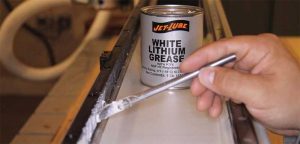When creating the program for the rough cut, approximately 0.58 mm (0.02 in.) should be left on the ‘Z’ axis to prevent the router from fully cutting through the material, leaving the part held in place. Also, the tool should be offset with an additional allowance of approximately 0.23 mm (0.008 in.) around the profile. By doing this, it leaves only a very small amount of material for the finishing tool to remove. This also reduces cutter loading, chip volume, as well as minimizing the chances of vibration spoiling the edge finish. The CNC router’s cut speed should be set to approximately 1.5 m/min (60 in./min), and the material should be cut in a ‘climb’ or clockwise direction.
The finishing pass, which cuts all the way through the material, concludes this process. To perform this pass, the profile allowance should be removed, and the cut speed should be reduced to about 1 m/min (40 in./min), cutting in the same direction. The finishing pass should produce little if any noise (the higher the noise is, it will result in a rougher cut). If the noise increases at any point during the finishing pass, the operator should stop the machine to check the work and reassess the situation. In some cases, one may need to reduce the feed speed or acceleration rate, or possibly even fit a new tool.
If the quality of the completed job starts to diminish, one should consider replacing the finishing tool. This will need to be changed on a regular basis to maintain the highest quality.
3. Regularly inspect and clean the vacuum table to minimize movement
Before one starts cutting, they should take a good look at the router deck to make sure it is free of dust and chips. If not, it should be cleaned. If chips and dust are present, it may prevent the part from lying flat on the sacrificial bed. If the part is not flat, the vacuum hold is reduced. Other steps one should follow include:
- Use a sacrificial bed/spoil board. A sacrificial bed, also known as a spoil board, is a disposable surface placed on top of the router to protect it from damage. Typically, medium-density fibreboard (MDF) is used. As it is a porous material, it allows air to flow through it to the vacuum pump.
- Examine the sacrificial bed. Visually inspect the sacrificial bed to determine if there is an overabundance of cutter marks, which can cause vacuum bleed. If so, it may be time to either replace the bed (which should be done approximately every six months) or skim the bed’s surface.
- Skim the sacrificial bed regularly. A clean, smooth surface is vital for effective material hold down. To maintain this surface, it is necessary to frequently skim the bed using a skimming tool. A general rule of thumb is to skim the bed at the beginning of each week.
- Check for plumbing leaks. If everything else appears okay (that is, there is a clean bed with no significant cutting marks) and there is still vacuum loss, check the pipework connecting the vacuum pump. Leaks will reduce the effectiveness of the vacuum hold.
4. Use different cutters for different materials for a high-quality edge finish
While a cutter may work well with one type of material, it might not always be the best choice for others. In fact, there are cutters specifically designed for certain materials. Typically, these cutters last longer and perform more effectively than general purpose cutters.
The main issue with using a cutter that is not specifically designed for use with the material one is working with is in the quality of the edge cut. If one is working on a display project that will be in a highly visible place, it is important to achieve a smooth, clean, and shiny edge versus one that is frosty, untidy, and rough. For example, when working with acrylic, if the wrong tool is used, the cut may result in a rough finish with ripple marks. The modifications in specifically designed cutters can make a substantial difference in the cut quality.
That said, it is a good idea for signmakers to talk to their CNC router supplier for advice and expertise on which tool to choose for a particular project. If the supplier has a local presence, one should visit the office and ask the supplier to test the material in question with several tools to determine the best one for the job.







